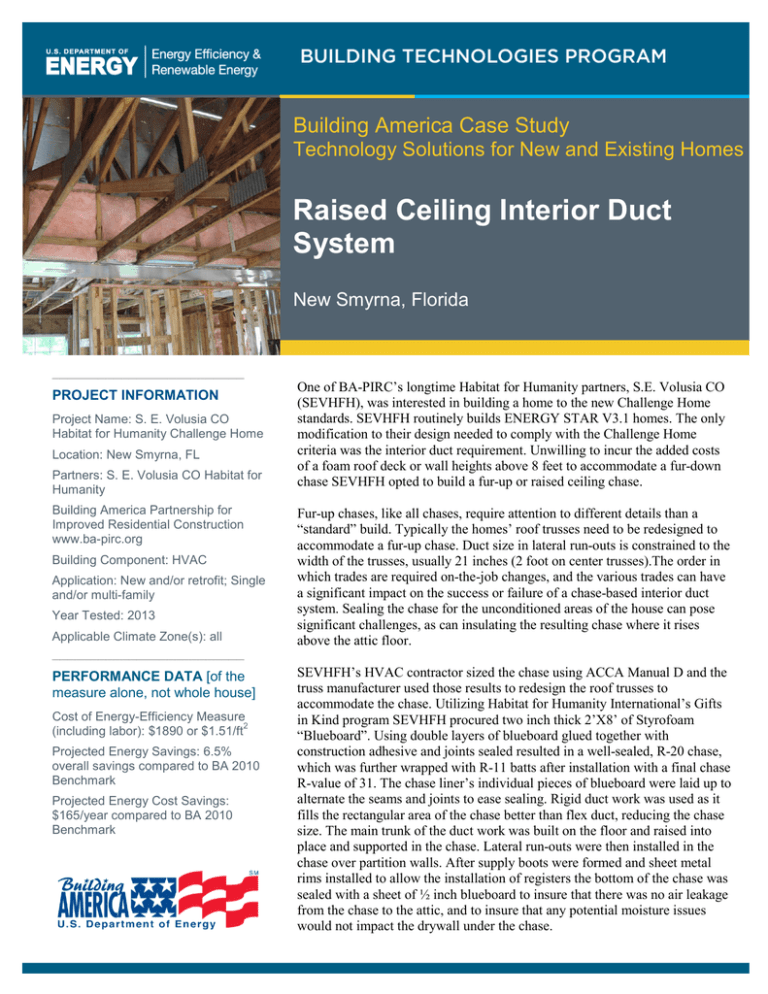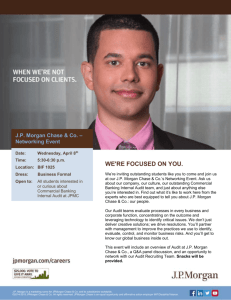Raised Ceiling Interior Duct System Building America Case Study
advertisement

Building America Case Study Technology Solutions for New and Existing Homes Raised Ceiling Interior Duct System New Smyrna, Florida _________________________ PROJECT INFORMATION Project Name: S. E. Volusia CO Habitat for Humanity Challenge Home Location: New Smyrna, FL Partners: S. E. Volusia CO Habitat for Humanity Building America Partnership for Improved Residential Construction www.ba-pirc.org Building Component: HVAC Application: New and/or retrofit; Single and/or multi-family Year Tested: 2013 Applicable Climate Zone(s): all _________________________ PERFORMANCE DATA [of the measure alone, not whole house] Cost of Energy-Efficiency Measure 2 (including labor): $1890 or $1.51/ft Projected Energy Savings: 6.5% overall savings compared to BA 2010 Benchmark Projected Energy Cost Savings: $165/year compared to BA 2010 Benchmark One of BA-PIRC’s longtime Habitat for Humanity partners, S.E. Volusia CO (SEVHFH), was interested in building a home to the new Challenge Home standards. SEVHFH routinely builds ENERGY STAR V3.1 homes. The only modification to their design needed to comply with the Challenge Home criteria was the interior duct requirement. Unwilling to incur the added costs of a foam roof deck or wall heights above 8 feet to accommodate a fur-down chase SEVHFH opted to build a fur-up or raised ceiling chase. Fur-up chases, like all chases, require attention to different details than a “standard” build. Typically the homes’ roof trusses need to be redesigned to accommodate a fur-up chase. Duct size in lateral run-outs is constrained to the width of the trusses, usually 21 inches (2 foot on center trusses).The order in which trades are required on-the-job changes, and the various trades can have a significant impact on the success or failure of a chase-based interior duct system. Sealing the chase for the unconditioned areas of the house can pose significant challenges, as can insulating the resulting chase where it rises above the attic floor. SEVHFH’s HVAC contractor sized the chase using ACCA Manual D and the truss manufacturer used those results to redesign the roof trusses to accommodate the chase. Utilizing Habitat for Humanity International’s Gifts in Kind program SEVHFH procured two inch thick 2’X8’ of Styrofoam “Blueboard”. Using double layers of blueboard glued together with construction adhesive and joints sealed resulted in a well-sealed, R-20 chase, which was further wrapped with R-11 batts after installation with a final chase R-value of 31. The chase liner’s individual pieces of blueboard were laid up to alternate the seams and joints to ease sealing. Rigid duct work was used as it fills the rectangular area of the chase better than flex duct, reducing the chase size. The main trunk of the duct work was built on the floor and raised into place and supported in the chase. Lateral run-outs were then installed in the chase over partition walls. After supply boots were formed and sheet metal rims installed to allow the installation of registers the bottom of the chase was sealed with a sheet of ½ inch blueboard to insure that there was no air leakage from the chase to the attic, and to insure that any potential moisture issues would not impact the drywall under the chase. Building America Efficient Solutions for New and Existing Homes Case Study: Raised Ceiling Interior Duct System DESCRIPTION Main duct is lifted into place. Ready to install the second layer of blueboard. Note the staggered joints and adhesive used to seal seams and attach layers together. Lessons Learned Lateral duct with chase running between trusses. Duct size is limited. Completed chase, ready for insulation wrap and drywall. Note sealed bottom using 1/2 inch blueboard. ____________________________ For more Information, see the Building America measure guideline report, http://apps1.eere.energy.gov/buildings/ publications/pdfs/building_america/me asure guide ducts new con.pdf • Team meetings are very important to insure quality work from all involved sub-contractors. • Constant vigilance is needed by job-site supervisor to insure proper implantation of system • There are additional costs for materials, and additional framing and drywall. A more expensive duct system (duct-board versus flex-duct) may be required due to space limitations. • Payback is impacted by other efficiency improvements, depending on the expense of the method employed. Therefore, cost benefits are seldom the sole motivation for implementation. Looking Ahead There are many Code interactions with this construction technique applying to smoke and flame spread of materials, using building cavities as ducts and Future refinements to the technique could use the chase as a passive return system without additional material. www.buildingamerica.gov LAB-XX-XXXX August 2013 The U.S. Department of Energy’s Building America program is engineering the American home for energy performance, durability, quality, affordability, and comfort.




![Ducts Inside Conditioned Space [Dropped Ceiling or Fur-down] Building America Case Study](http://s2.studylib.net/store/data/013051504_1-949dfbc94f139f37819f216521fe0932-300x300.png)

